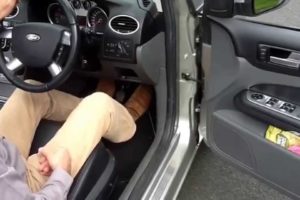2 Second Rule
The safe and correct following distances are difficult to establish. For this reason, the 2 second rule is used to gain a safe following distance at any speed and is also an easy method for all drivers to remember.
The rule is very simple and easy to understand by using the description and diagram below. Remaining at least 2 seconds from the vehicle in front will provide a distance of one car length per 5 mph, at which ever speed you drive. This distance is of course extended for the 2 seconds the faster you travel. Using the 2 second rule helps to significantly reduce accidents or reduce collision damage if one occurs.
Using the 2 second rule provides not only a general safer way of driving, but can also help to save fuel, brake wear and paint damage as a result of stone chips occurring due to driving too close to the car in-front. See how to save petrol for further information.
The 2 second rule should also be utilised by the learner driver as the driving test examiner will most certainly fail your driving test for driving too close to a vehicle (tailgating), or remaining close to the vehicle for too long.
The simple and effective 2 second rule only applies to dry weather conditions and should be extended depending on the weather. Generally if the conditions are wet, the 2 seconds should be double to 4 seconds to allow for longer braking distances due to slippery roads. For frosty or icy conditions, this needs to be extended further.
2 Second Rule Explained
2 SECOND RULE EXPLAINED
Let’s suppose you are driving along a relatively straight road at 30 mph as an example. To estimate the minimum and safe following distance, allow the car in front (the red car) to pass a fixed object.
This can be any object that is easy to distinguish such as a road marking, lamp post, although in this case in the diagram, it’s a road sign. As the rear of the car in front roughly lines up with your chosen reference marker, count to 2 seconds. If before you have reached 2 seconds your vehicle has passed the same reference marker, you will need to increase your following distance and try again.
The 2 second rule isn’t just for the car in-front however. If a car is driving too close behind you (tailgating), you will also need to take their thinking distance into account by leaving a sufficient and safe distance between yourself and the car in-front.
By following the 2 second rule, if the car in front of you brakes sharply, you will be able to slow down in good time, but also allow plenty of time for the car behind you to slow down. It’s also essential to learn safe braking techniques such asprogressive braking. Progressive braking once learned allows for safer driving and less wear and tear on your vehicle.
DRIVING TOO CLOSE TO PARKED CARS
Driving unnecessarily close to parked cars more than once is likely to fail the driving test. Try if possible to leave at least around a 1 metre gap (or a car doors width) from the side of your car to the side of the parked car on the left. This is in case a car door opens and with this distance you should hopefully avoid it. It is of course not always possible to leave a 1 metre gap. If the street is narrow with parked cars, try to keep an equal gap either side from your left and right side, whatever this distance may be. You must slow down to an appropriate speed which it likely to be around 10 – 15 mph. Driving in a confined space during a driving test is acceptable providing the speed is sensible.
THINKING DISTANCE, BRAKING DISTANCE AND STOPPING DISTANCES
Further information can be found for a cars stopping distance in various weather conditions, at various speed limits. Stopping distances are a necessary part of the theory test questions and is used alongside the 2 second rule for safer driving.
2 SECOND RULE FOR LEARNER DRIVERS
Practice the 2 second rule as often as possible and before long, you will find that you maintain a safe following distance without need of practicing this technique. During the driving test it is acceptable to drive too close to a vehicle when for example:
joining a dual carriageway
following a vehicle after making a turn
following a vehicle after moving off from a stationary position
It is important after these situations to impose the 2 second rule as soon as is safely possible, with safe regard to the vehicle behind.
Tag:Course





